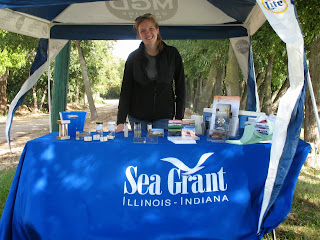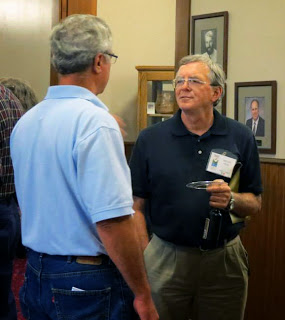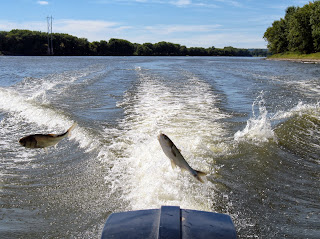October 10th, 2013 by Irene Miles
John Saltanovitz, currently a senior at Purdue earning a bachelor’s degree in Natural Resources and Environmental Science, worked this past summer as a sustainable communities outreach intern with IISG’s Kara Salazar. He wrote in to detail his experience getting hands-on in the environmental science field.
 “When I started college, I was not aiming towards a career in environmental science. But as my classes progressed and I learned more about the topics, I realized how important the field was. There are so many issues that, if left ignored, could cause problems for future generations. Working to solve these problems is why I chose environmental science as my major. I learned about the internship with IISG from an email my department sent out, and it seemed like an amazing opportunity to get hands-on with the field I wanted to be involved in.
“When I started college, I was not aiming towards a career in environmental science. But as my classes progressed and I learned more about the topics, I realized how important the field was. There are so many issues that, if left ignored, could cause problems for future generations. Working to solve these problems is why I chose environmental science as my major. I learned about the internship with IISG from an email my department sent out, and it seemed like an amazing opportunity to get hands-on with the field I wanted to be involved in.
My specific focus was with community outreach. I worked with Kara on creating publications that could help communities be more aware of environmental problems and how to fix them. My main project was creating a zero waste guide that could be used for planning local events in the future. The guide helps to provide ideas and statistics behind zero waste events, how they work, and how to plan for them. My hope is that this document will encourage people in the community to work towards being more environmentally friendly.
My work this summer has showed me how much effort those in the outreach field put forth to help make a difference. I’ve always grown up around the Great Lakes, but this internship really opened my eyes to all of the different projects people are doing to assist and protect the Great Lakes region. Before this internship, the idea of research/outreach with the Great Lakes hadn’t crossed my mind, but this summer’s experiences have greatly increased my interest in and passion for the subject. I’ve learned that no problem is too small or unimportant when it comes to creating a better place to live and a healthier environment.
I plan on continuing my studies in environmental science and working towards a degree in environmental engineering. My internship showed me how many possibilities are out there and what can be accomplished with hard work. I’ve met so many great people through IISG who all have a passion for what they do. It was a blessing to be involved in an organization like IISG. The only downside is that the summer felt like it went by so fast. I wish that I could have had more time to continue working and networking in the field.”
John is one of four interns who worked with IISG this summer. You can look forward to additional posts soon.
October 7th, 2013 by Irene Miles
Among the many Areas of Concern (AOCs) designated by the International Joint Commission, Illinois-Indiana Sea Grant has been involved in several providing research and reports on local stakeholders perceptions of cleanup operations and ways in which they are affected by the projects. This latest report details the St. Louis River AOC.
From IISG’s Caitie McCoy:
“A report on stakeholder perceptions of the St Louis River Area of Concern (AOC) and attitudes toward the cleanup and restoration work is now available. This summer, I traveled to the St Louis River with my intern Emily Anderson to perform social science research on community attitudes toward remediation and restoration. The river is located on the border between Duluth, MN and Superior, WI, and is the largest U.S. AOC. The report will help tailor efforts of the Spirit Lake Outreach Team toward local stakeholder needs and interests at the current Great Lakes Legacy Act site in the river, Spirit Lake.
Emily provided her thoughts on the experience – ‘Being part of the research team for this project allowed me to experience firsthand how social science contributes to environmental remediation and restoration. Conducting the interviews with Caitie, I met so many intriguing and knowledgeable people; I now see the direct implications that stakeholder input can have for both outreach and project design.’
This assessment is part of a larger effort to understand how AOC work influences stakeholder perceptions and use of waterways at a regional scale. A similar report on the Sheboygan River is available and a follow-up report on Sheboygan, post-cleanup, is coming soon.”
October 3rd, 2013 by Irene Miles
Alice Denny, a recent graduate from Hartwick College, spent the summer working with the Illinois-Indiana Sea Grant aquatic invasive species team in Glencoe, Illinois, and wrote in to share details about her experience.
“I’ve always had a love for being outdoors. Several family members of mine work in the environmental field, so that helped spark my interest in biology and environmental science. A relative of mine mentioned the IISG internship program to me last summer, but I was away at school and unavailable. I was very thankful that this internship was offered again this year as I finally got the chance to get involved with Sea Grant.
I worked with the Aquatic Invasive Species Outreach Team in Glencoe, IL. Specifically I worked with fishing tournament anglers and organizers, helping that group prevent the spread of aquatic invasive species. Anglers are a large and crucial audience when trying to reach recreational water users, as they are dependent on healthy water for fishing. However, little information was available on this audience and what they do in terms of AIS prevention. I conducted a survey with tournament organizers to better understand what their role was in AIS prevention, and I attended several fishing tournaments throughout the summer to conduct public outreach.
 I’ve gained so much more experience with public outreach and education through this internship. Going to events throughout the summer has provided me with experience explaining complex environmental issues to the public. I’ve always had an interest in ecology, but this internship has really fueled an interest in aquatic ecology, especially in the Great Lakes region. The Great Lakes are an important natural resource for us, and my internship gave me an opportunity to help protect the Lakes in a meaningful way.
I’ve gained so much more experience with public outreach and education through this internship. Going to events throughout the summer has provided me with experience explaining complex environmental issues to the public. I’ve always had an interest in ecology, but this internship has really fueled an interest in aquatic ecology, especially in the Great Lakes region. The Great Lakes are an important natural resource for us, and my internship gave me an opportunity to help protect the Lakes in a meaningful way.
At this point, I want to continue working in the environmental field before going back to school for any graduate work. At the moment, I’ve just been hired to continue with IISG as an outreach assistant. I’m obviously extremely excited to stay on board with the AIS team and continue working with recreational water users as well as other audiences critical to preventing the spread of these species.”
Alice is one of four interns who worked with IISG this past summer, and we’ll be featuring posts from the others coming up in future blog posts.
September 25th, 2013 by Irene Miles
The Purdue University Department of Forestry and Natural Resources (FNR) celebrated their centennial anniversary from September 20-22, and included back-to-class sessions, tours of FNR buildings including the aquaculture research laboratory, and a Saturday evening banquet. More than 250 guests, including many FNR alumni, joined in the celebrations.
 FNR has spent the past 100 years training professional foresters, fishery and wildlife scientists, and natural resource managers who help to preserve and protect environmental resources throughout the country.
FNR has spent the past 100 years training professional foresters, fishery and wildlife scientists, and natural resource managers who help to preserve and protect environmental resources throughout the country.
Illinois-Indiana Sea Grant (IISG) has proudly partnered with FNR for more than 30 years. Brian Miller, IISG Program Director, said, “The Illinois-Indiana Sea Grant College Program highly values our 30 year partnership between NOAA, Purdue University, and the University of Illinois. This type of bi-state partnership only works in one other Sea Grant college in the country, and only works because of the mission-driven spirit of collaboration that exists on both of our campuses. The innovation, dedication and creativity of FNR have helped make the Illinois-Indiana Sea grant college program successful and enabled us to achieve positive impacts for local communities and the Great Lakes ecosystem.”

Recent IISG work was showcased during a welcome reception Friday night, and IISG staff assisted in organizing several of the celebration events throughout the weekend. Numerous current IISG staff members have worked closely with FNR, including Miller, Angela Archer, Carolyn Foley, Tomas Hӧӧk, Kwamena Quagrainie, and Kara Salazar, and the partnership continues to offer a crucial link in protecting coastal areas and waterways.
*Photos courtesy the FNR Centennial Committee
September 19th, 2013 by Irene Miles
Illinois-Indiana Sea Grant’s Caitie McCoy and others have just completed work on a new curriculum for elementary and high school science students.
Helping Hands: Restoration for Healthy Habitats offers lessons and hands-on activities to connect students in the Great Lakes with recent or ongoing cleanup and restoration projects happening in their communities. The range of activities offers new ways to engage students with real-life examples that show environmental science in action.
Teachers interested in having Sea Grant lead the curriculum in their school should contact Caitie McCoy. Caitie can work with the teacher to customize curriculum to meet school-specific needs. The curriculum expands Great Lakes literacy among students, many of whom may become future researchers and educators.
Community leaders in Areas of Concern that would like to help Sea Grant lead or set up an educational program are also encouraged to contact Caitie. The complete curriculum is free to download at the link above.
September 16th, 2013 by Irene Miles
Recent research indicates that even a handful of Asian carp, between just ten and twenty fish, could establish an ecologically damaging population in the Great Lakes.
From ScienceDaily.com:
“Published this week in the Biological Invasions journal, research from Professor Kim Cuddington of the Faculty of Science at Waterloo indicates that the probability of Asian carp establishment soars with the introduction of 20 fish into the Great Lakes, under some conditions…
‘This species will have a huge impact on the food web,’ says Professor Cuddington. ‘Not only is it a fast-growing fish physically, but the population itself grows very quickly. A female can lay well over a million eggs a year, and with no known predators present in the Great Lakes, the Asian carp could dominate the waters and impact fisheries.’…
Individual fish have already been caught in two of the Great Lakes. The probability of Asian carp establishment changes dramatically if only 10 of the creatures are introduced. With 10 fish, the probability of a population of Asian carp is only 50 per cent, but with 20 fish, it jumps to 75 per cent, under some conditions.”
September 12th, 2013 by Irene Miles
IISG staff will have the opportunity to see aquaculture in action next week while touring the Bell Aquaculture facility in Albany, IN. IISG’s Kwamena Quagrainie has been studying and providing expert advice to aquaculture operations in the Midwest and worldwide for many years, and will be giving the staff more information on how the facility provides millions of pounds of sustainably grown fish to the market each year.
Aquaculture has been a growing food field in the state of Indiana, and a recent feasibility study funded in part by IISG (available online soon at our research projects page) shows that it may have significant potential in Illinois as well.
Additionally, Purdue University produced this great video about aquaponics, which is an extension of aquaculture where fish and plants are raised sustainably and simultaneously in a mutually beneficial system.
Learn more about aquaculture on our aquaculture page.
September 6th, 2013 by Irene Miles
A recent study of Lake Michigan is indicating a high level of prescription drugs in the water, helping to emphasize the importance of proper disposal and the difficulty that water treatment facilities have removing these compounds.
From MLive.com:
“The study was performed by researchers at the University of Wisconsin-Milwaukee and examined water samples taken near a Milwaukee water treatment plant and from the city’s harbor, Environmental Health News reported.
Researchers found high levels of the anti-diabetes drug metformin, the anti-bacterial drug triclosan and the antibiotic sulfamethoxazole as well as high levels of caffeine in both water and sediment samples taken from the lake. In total, 38 different compounds were found in the samples in some concentration, including acetaminophen, testosterone, codeine and several antibiotics.”
Follow the link above for the complete article (including a link to the study and additional reading), and find out more about the importance of proper medicine disposal at our UnwantedMeds.org site.
September 5th, 2013 by Irene Miles
The SeaPerch Program, sponsored by the Office of Naval Research, brings robotics and underwater science together to enhance classroom activities and curricula for a variety of grade levels. Illinois-Indiana Sea Grant recently sponsored a contestto give away several of the kits to teachers of grades 6-12, and the six winners will be receiving their new kits in the coming weeks. Blake Landry, project partner and coordinator of the University of Illinois’ SeaPerch Program, is working with IISG to provide continued support and training to the teachers and their students.
Teachers were asked to complete a survey and provide details about how they wanted to integrate the SeaPerch technology into their science lessons, and the responses were outstanding. In addition to bolstering their own classroom activities, several teachers hoped to use the starter kit and accompanying science lessons to share with teachers throughout the area. One winner wrote, “The SeaPerch program and applications would be an excellent topic to present at the Illinois Computing Educators Conference targeting science teachers and integration of science and engineering.”
In addition to offering a new tool to teachers, the contest helps to further activity and curriculum development and provides educators an opportunity to network and share their ideas with others. All of which complements IISG’s goal of fostering Great Lakes science literacy and engagement throughout the region.
“When I started college, I was not aiming towards a career in environmental science. But as my classes progressed and I learned more about the topics, I realized how important the field was. There are so many issues that, if left ignored, could cause problems for future generations. Working to solve these problems is why I chose environmental science as my major. I learned about the internship with IISG from an email my department sent out, and it seemed like an amazing opportunity to get hands-on with the field I wanted to be involved in.
My specific focus was with community outreach. I worked with Kara on creating publications that could help communities be more aware of environmental problems and how to fix them. My main project was creating a zero waste guide that could be used for planning local events in the future. The guide helps to provide ideas and statistics behind zero waste events, how they work, and how to plan for them. My hope is that this document will encourage people in the community to work towards being more environmentally friendly.My work this summer has showed me how much effort those in the outreach field put forth to help make a difference. I’ve always grown up around the Great Lakes, but this internship really opened my eyes to all of the different projects people are doing to assist and protect the Great Lakes region. Before this internship, the idea of research/outreach with the Great Lakes hadn’t crossed my mind, but this summer’s experiences have greatly increased my interest in and passion for the subject. I’ve learned that no problem is too small or unimportant when it comes to creating a better place to live and a healthier environment.I plan on continuing my studies in environmental science and working towards a degree in environmental engineering. My internship showed me how many possibilities are out there and what can be accomplished with hard work. I’ve met so many great people through IISG who all have a passion for what they do. It was a blessing to be involved in an organization like IISG. The only downside is that the summer felt like it went by so fast. I wish that I could have had more time to continue working and networking in the field.”




